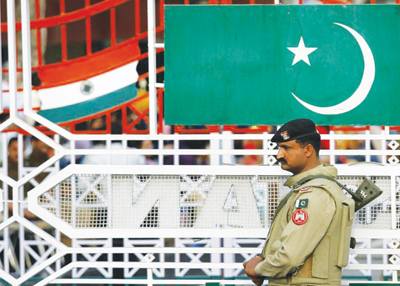Sunday Times 2
Rising India-Pakistan tensions, but little planning
View(s):It was in that sour mood that New Delhi reacted with increasing anger to Pakistan’s support for Islamist militants targeting India in Kashmir and beyond. In October 2001, nearly 40 people were killed in a suicide attack on the legislative assembly of Jammu and Kashmir state in its summer capital Srinagar. When militants attacked the Indian parliament in Delhi on December 13, 2001 – an attack blamed on the Pakistan-based Jaish-e-Mohammed – India mobilised for war. Soon close to a million men were deployed on either side of the border in a tense standoff that was not resolved until the following summer, and only then after intense U.S.-led international diplomacy.

A Pakistani Ranger stands near the Pakistani flag and Indian flag (L) during a daily parade at the Pakistan-India joint check post at Wagah border, on the outskirts of Lahore (REUTERS)
To those of us who witnessed the build-up to the 2001-2002 standoff, the rising tensions between India and Pakistan – with both sides accusing the other of escalating fighting on the Line of Control dividing disputed Kashmir – bear a troublesome resemblance to that time. Then and now are bookended by the U.S. presence in Afghanistan which began in 2001 and is due to end in 2014.
In the interim was a period of relative calm on the India-Pakistan front. The two countries agreed a ceasefire on the Line of Control in late 2003; infiltration of militants from Pakistan into Indian Kashmir slowed to a trickle; violence in the Kashmir Valley – at the heart of a separatist revolt – came down dramatically. Even after 166 people were killed in the 2008 attack on Mumbai, blamed by the United States and India on the Pakistan-based Lashkar-e-Taiba, Delhi only “paused” talks and took no retaliatory military action.
There were many reasons for that restraint: Indian Prime Minister Manmohan Singh was personally committed to the peace process; Delhi preferred to focus on its economic growth; the failure of the 2001-2002 mobilisation highlighted the difficulties of war between two countries which openly tested nuclear weapons in 1998; Pakistan was preoccupied with Afghanistan.
And there are many reasons for it breaking down now: Singh has been weakened by domestic political and economic crises while his Congress party, facing elections next year, is being taunted by the opposition Bharatiya Janata Party (BJP) for going soft on Pakistan while Lashkar-e-Taiba founder Hafez Saeed, seen by India as the mastermind behind Mumbai, preaches openly at home.
Adding to that are concerns in India that as the Afghan war winds down, Pakistan will redirect Islamist militants to the Kashmir jihad – just as it did when the Soviets withdrew from Afghanistan in 1989. Pakistan denies backing the militants. And again an aggrieved India is looking on fearing the United States might stitch up a deal with Pakistan to give the Taliban a share of power in Afghanistan as it tries to find a respectable exit to the long Afghan war.
But whatever the many different reasons, what should worry people in South Asia and beyond is that the relative calm in India-Pakistan relations during the U.S.-led war in Afghanistan may turn out to have been the exception rather than the rule. (The deterrent effect of both countries having nuclear weapons played a role; but did not prevent either the Kargil war fought on the Line of Control in 1999, or the 2001-2002 standoff where troops were mobilised all along the border.)
Nobody is suggesting the two countries are hurtling towards war. India is still focused on reviving economic growth and has little to gain from a war. Even Narendra Modi, the presumed prime ministerial candidate for the BJP in the coming elections, has built his reputation by cultivating ties with the business community, restraining his traditional hawkishness on Pakistan. And Pakistan has far too many problems dealing with the Tehrik-e-Taliban Pakistan (TTP) and its allies in al Qaeda, based in the tribal areas bordering Afghanistan, to risk a crisis on the Indian border on the east.
So there is still time for India and Pakistan to build lines of communication to help both countries manage a crisis that neither wants, and to consider how to improve their signalling, particularly on the use of nuclear weapons. And there is still time for the outside world to work out how they could intervene to prevent any new crisis from escalating. The problem is that, lulled by the relative restraint of the last decade or so, few are planning for the next crisis. Most debate is limited to, and defined by, what happened over the last 10 years – the discussion revolves around whether the LoC ceasefire will hold, or the extent of India-Pakistan rivalry in Afghanistan. If these years prove to be an anomaly for India-Pakistan relations, everyone needs to be thinking much more broadly.
And of course, the idea that there is still time assumes that al Qaeda and its allies do not try to exploit the rising tensions, using a major attack in India to throw a match into the tinderbox.
Follow @timesonlinelk
comments powered by Disqus

